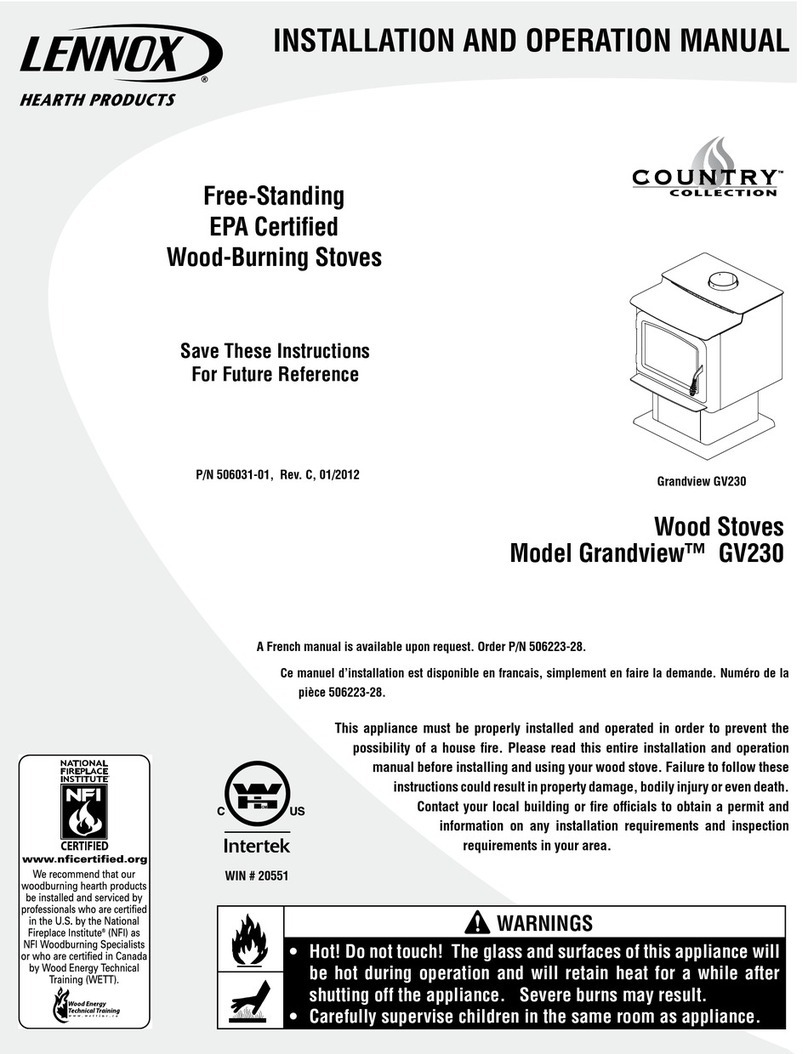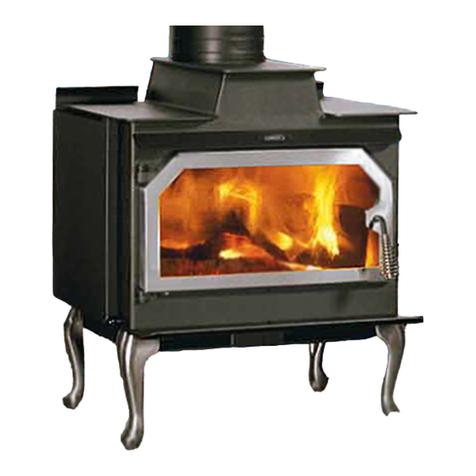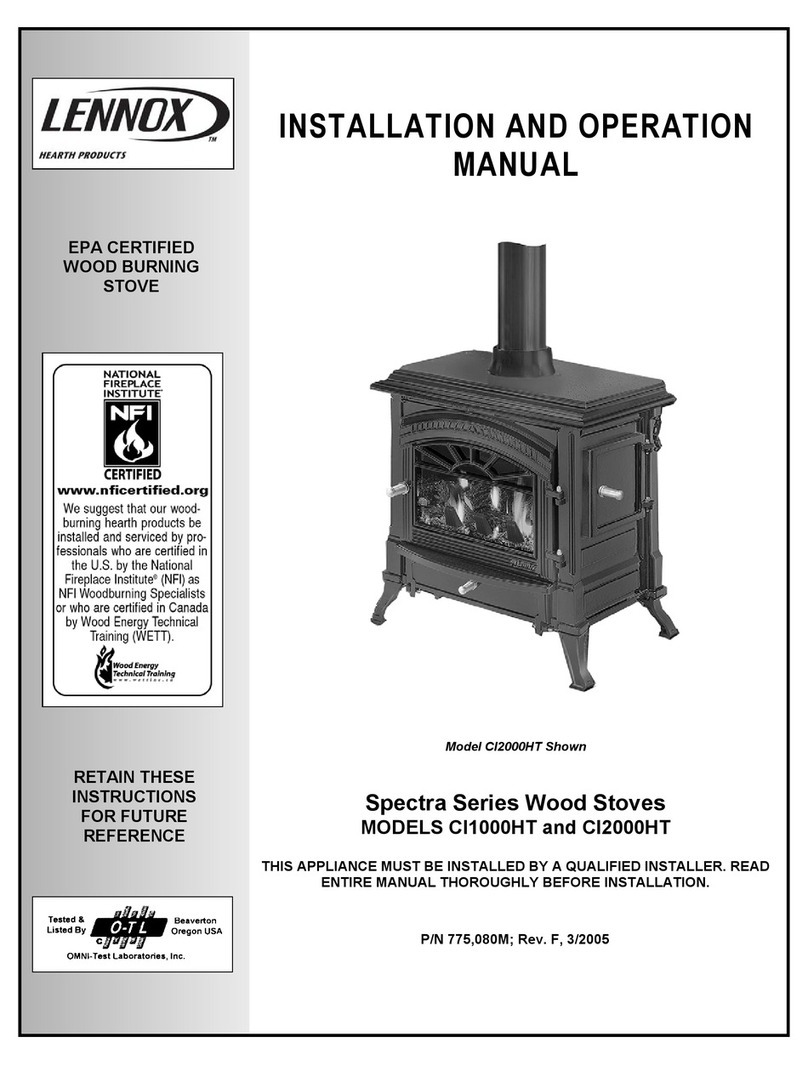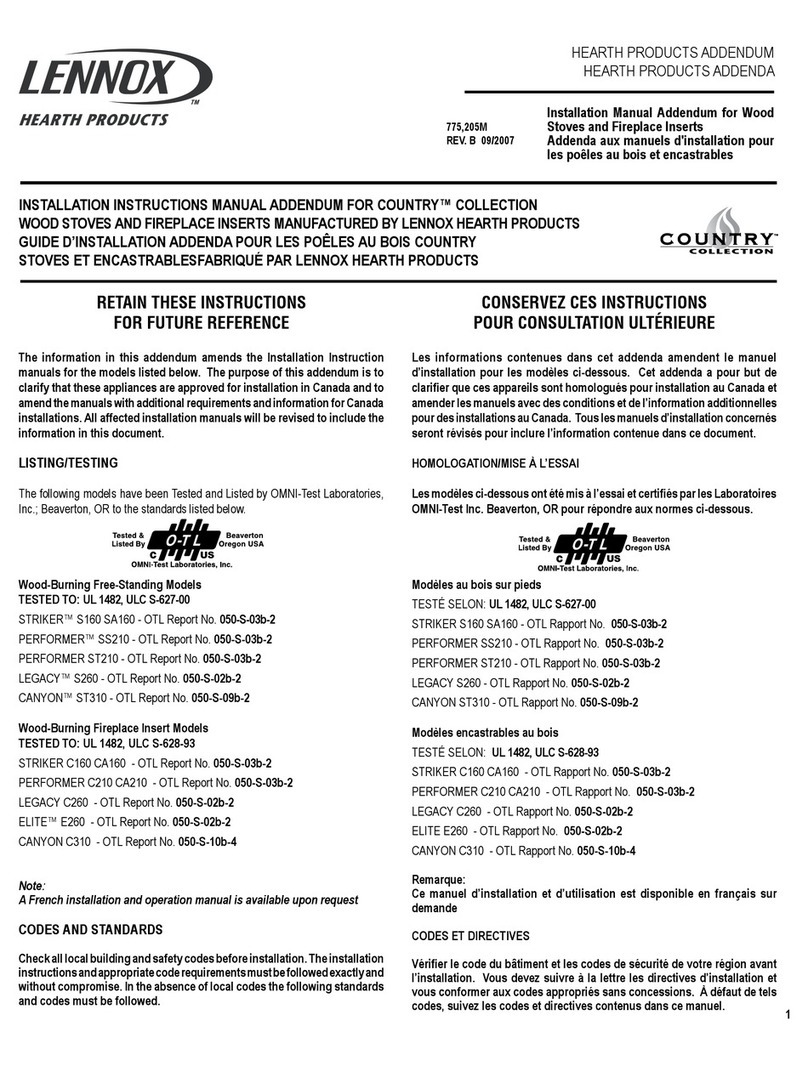
3
IMPORTANT SAFETY AND WARNING
INFORMATION
READ THIS MANUAL IN ITS ENTIRETY AND UNDER-
STAND THESE RULES TO FOLLOW FOR SAFETY.
Planning Installation Safety and General
Installation
Operation
Maintenance
Troubleshooting
Parts / Accessories
1. When this room heater is not properly installed, a house
fire may result. To reduce the risk of fire, follow the instal-
lation instructions. Contact local building or fire officials
about restrictions and installation inspection requirements
in your area.
2. Wear gloves during installation to avoid injury from sharp
edges on the stove and/or its parts.
3. This unit is designed and engineered to burn only dry, well-
seasoned wood. Burning wet wood will greatly reduce the
stove’s efficiency, produce excessive amounts of smoke
and can cause dangerous chimney fires due to creosote
build-up.
4. Before opening the door, the draft control must be fully open
to avoid possible combustion flash (ignition of hot volatile
gases as the door is opened).
5. Never use gasoline, gasoline-type lantern fuel, kerosene,
charcoal lighter fluid,or similar liquids to startor ’freshenup’
a fire in this heater. Keep all such liquids well away from
the heater while it is in use. DO NOT USE CHEMICALS OR
FLUIDS TO START THE FIRE.
6. While burning, fuel utilizes oxygen from the air in the room.
Be sure to allow an adequate amount of fresh air into the
room where the stove is burning.
7. The outside surface of the stove will be hot while burning
properly and can set items like clothing and curtains on
fire. Keep furnishings and other combustible materials
away from the stove. Using the heat from the stove to dry
wet clothing can be hazardous if clothes are placed too
near the surface of the stove.
8. HOT WHILE IN OPERATION. KEEP CHILDREN, CLOTHING
FURNISHINGSAND COMBUSTIBLE MATERIALA CONSIDER-
ABLE DISTANCE AWAY. CONTACT MAY CAUSE SKIN BURNS.
Do not allow children to play near the stove without close
supervision. Do not touch the stove while it is burning.
Use extreme caution while the unit is in use. Surface tem-
peratures become dangerously hot and can cause serious
burns.
9. Do not allow anyone to operate the stove who is not familiar
with the operating instructions.
10. Attempts to achieve heat output rates that exceed stove
design specifications can result in permanent damage to
the stove. Never leave your stove unattended on high burn
rates. This may cause overfiring. Overfiring the stove may
cause a house fire. If the stove glows, you are overfiring.
11. Keep a water hose or hand-operated fire extinguisher close
for safety.
12. Smoke Detectors - Since there are always several poten-
tial sources of fire in any home, we recommend installing
smoke detectors. If possible, install the smoke detector in
a hallway adjacent to the room (to reduce the possibility
of occasional false activation from the heat produced by
the stove). If your local code requires a smoke detector
be installed within the same room, you must follow the
requirements of your local code. Check with your local
building department for requirements in your area.
13. Inspect your chimney at least once a month during the burn-
Safety and General
ing season to check for soot and creosote accumulations.
Any accumulations over 1/8” thick should be removed by
a professional chimney sweep. Do not attempt to burn out
heavy creosote accumulations with a hot fire. If large ac-
cumulationsare occurring, review your burningprocedures.
14. If a creosote fire should develop, the fire department should
be called immediately and then attempts should be made
to control the fire until assistance arrives. If a “runaway”
fire should develop causing over-heating of the stove, the
door and draft regulators should be closed immediately.
The fire should die down once deprived of oxygen. After a
severe chimney fire, the complete chimney system should
be checked before further use.
15. Do Not Use Grate Or Elevate Fire - Build Wood Fire Directly
On Hearth (firebrick). Do not use andirons or other methods
of supporting the fuel.
16. Please read this entire manual before you install and use
your new room heater. Failure to follow instructions may
result in property damage, bodily injury, or even death.
17. Check all local building and safety codesbefore installation.
The installation instructions and appropriate code require-
ments must be followed exactly and without compromise.
In the absence of local codes the following standards and
codes must be followed.
18. In the U.S.A, install in accordance with the National Fire
Protection Association’s Code, NFPA 211, Standards for
Chimneys,Fireplaces,Ventsand Solid-Fuel-Burning Appli-
ances, or similar regulations, may apply to the installation
of a Solid-Fuel-Burning appliance in your area. In Canada,
the guideline is established by the CSA Standard, CAN/
CSA-B365-M93, Installation Code for Solid-Fuel-Burning
Appliances and Equipment.
19. DO NOT CONNECT TO OR USE IN CONJUNCTION WITH ANY
AIR DISTRIBUTION DUCTWORK UNLESS SPECIFICALLY
APPROVED FOR SUCH INSTALLATIONS.
20. WARNING: BURNING IMPROPER FUEL (I.E. CHARCOAL)
CAN RESULT IN CARBON MONOXIDE POISONING, WHICH
MAY LEAD TO DEATH!
21. Carbon Monoxide Poisoning - Early signs of carbon monox-
ide poisoning resemble the flu with headaches, dizziness,
or nausea. If you have these signs, get fresh air at once!
Have the heater inspected by a qualified service technician.
Some people are more affected by carbon monoxide than
others. These include pregnant women, people with heart
or lung disease or anemia, those under the influence of
alcohol, and those at high altitudes.
22. Failure to use manufacturer provided parts, variations in
techniques andconstruction materials orpractices other than
those described in this manual may create a fire hazard and
void the limited warranty.
23. Do not make any make-shift compromises during installa-
tion. Any modification or alteration may result in damage
to the appliance or dwelling and will void the warranty,
certification and listings of this unit.
24. These appliances are designed as supplemental heaters.
Therefore, it is advisable to have an alternate heat source
when installed in a dwelling.
25. Do Not Overfire - If Heater or Chimney Connector Glows,
You Are Overfiring.
26. DO NOT CONNECT THIS UNIT TO A CHIMNEY FLUE SERV-
ING ANOTHER APPLIANCE.
27. DO NOT BURN GARBAGE OR FLAMMABLE FLUIDS SUCH
AS GASOLINE, NAPHTHA OR ENGINE OIL.































